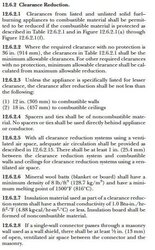Hello! I am new to the site - and new to heating with wood.
We are close to purchasing a Jotul F100 to heat our less than 600 sq ft area. Due to space limitations we will need to use an NFPA 211 Protected Surface on the walls to reduce clearance. I would like to use ceramic tile and understand the part about the 1 inch air space behind the cement board.
Can one of you help me understand the part about the top and bottom air gap? Does that mean that we will be creating tile "panels" that float out from the wall with a visible gap behind them?
Thank you for sharing your knowledge.
We are close to purchasing a Jotul F100 to heat our less than 600 sq ft area. Due to space limitations we will need to use an NFPA 211 Protected Surface on the walls to reduce clearance. I would like to use ceramic tile and understand the part about the 1 inch air space behind the cement board.
Can one of you help me understand the part about the top and bottom air gap? Does that mean that we will be creating tile "panels" that float out from the wall with a visible gap behind them?
Thank you for sharing your knowledge.


